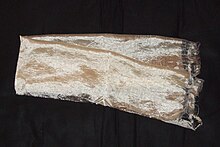Khata
| Khata | |||||||||||||||
|---|---|---|---|---|---|---|---|---|---|---|---|---|---|---|---|
 A Tibetan khata | |||||||||||||||
| Chinese name | |||||||||||||||
| Chinese | Khăn ha-đa | ||||||||||||||
| |||||||||||||||
| Tibetan name | |||||||||||||||
| Tibetan | ཁ་བཏགས་ | ||||||||||||||
| |||||||||||||||
| Mongolian name | |||||||||||||||
| Mongolian Cyrillic | хадаг | ||||||||||||||
| Mongolian script | ᠬᠠᠳᠠᠭ | ||||||||||||||
| Nepali name | |||||||||||||||
| Nepali | खतक khatak | ||||||||||||||
| Dzongkha name | |||||||||||||||
| Dzongkha | བཀབ་ནས | ||||||||||||||
| Buryat name | |||||||||||||||
| Buryat | хадаг khadag | ||||||||||||||
| Tuvan name | |||||||||||||||
| Tuvan | кадак kadak | ||||||||||||||
| Kyrgyz name | |||||||||||||||
| Kyrgyz | حاداق хадак hadak | ||||||||||||||

Akhata/ˈkætə/orkhatag[1][a]is a traditional ceremonialscarfinTibetan Buddhismand inTengriism.[5][better source needed]It is widely used by the Tibetan, Nepalese, Bhutanese, Ladakhi, Mongolian, Buryat, and Tuvan peoples on various occasions. It originated inTibetan cultureand is common in cultures and countries where Tibetan Buddhism is practiced or has strong influence.[citation needed]The practice of usingkhatashas influenced people of other communities too who are in close relation to these communities. It is predominantly used in Tibet, followed by other parts of the world. It is a symbol of honour and respect. It is used in Tibetan religious ceremony and in traditional dances, and is offered in monasteries and in temples.
InNepal,akhatais used as a gift for various occasions like wedding, graduation, electoral victory, winning an award and several other major lifestones. Generally, the guests or invitees at the reception would put khata on the host of such parties. It is used by both Hindus and Buddhists of Nepal in that manner.
History
[edit]Tibetan people used to give animal skins as gifts because there was no silk in Tibet. According to theBonhistorical record, people would put sheep wool around their necks during the time of the ninth king, Degong Jayshi, and head for some religious rituals. This tradition was passed down from that moment onwards. People began making scarves and using silk over time. So, the scarf replaced the plain sheep's wool and people put scarves on the neck and head.
Uses and types
[edit]The khata symbolizes purity and compassion and is worn or presented with incense at many ceremonial occasions, including births, weddings, funerals, graduations and the arrival or departure of guests. When given as a farewell gesture it symbolizes a safe journey. When given to arriving guests it symbolizes welcome. They were usually made ofsilkbut now much more commonly cotton or polyester. Tibetan khatas are usuallywhite,symbolising the pure heart of the giver,[6]though it is quite common to findyellow-goldkhata as well.Tibetan,Nepali,andBhutanesekhatas feature theashtamangala.There are also special multi-colored khatas.Mongoliankhatas are usuallyblue,symbolizing theblue sky.In Mongolia, khatas are also often tied toovoos,suvargas,or special trees and rocks.

Explanatory notes
[edit]- ^Tibetan:ཁ་བཏགས་;Dzongkha:དར་dhar;MongolianandBuryat:ᠬᠠᠳᠠᠭхадаг,khadag[ˈχatəq];Tuvan:кадакorхадак,kadakorhadak,[qɐˈtɐq]or[χɐˈtɐq];Nepali:खतकkhatak[ˈkʰʌt̪ʌk];simplified Chinese:Khăn ha-đa;traditional Chinese:Khăn ha-đa;pinyin:hādá/hǎdá.[2][3][4]
References
[edit]- ^Das, Sarat Chandra (1902). Rockhill., William Woodville (ed.).Journey to Lhasa and Central Tibet.London: Royal Geographical Society. p. 32.OCLC557688339.
... handing him a scarf (khatag), I expressed the hope that we might meet next year.
- ^Hiện đại Hán ngữ từ điển ( thứ bảy bản )[A Dictionary of Current Chinese (Seventh Edition).]. Bắc Kinh.Beijing:Thương vụ ấn thư quán.The Commercial Press.1 September 2016. p. 505.ISBN978-7-100-12450-8.
【 khăn ha-đa 】 hǎdá
- ^Hiện đại Hán ngữ quy phạm từ điển ( đệ 3 bản )[A Standard Dictionary of Current Chinese (Third Edition).]. Bắc Kinh.Beijing:Ngoại ngữ dạy học cùng nghiên cứu nhà xuất bản. Foreign Language Teaching and Research Press. May 2014. p. 507.ISBN978-7-513-54562-4.
【 khăn ha-đa 】 hǎdá
- ^"Giáo dục bộ 《 trọng biên quốc ngữ từ điển chỉnh sửa bổn 》2021".
- ^"The Eternal Blue Sky"(PDF).Hoop. 2014.Retrieved2016-06-19.
- ^Staff."Khata/Tibet" roof of the world "".Oracle ThinkQuest Education Foundation.Retrieved2010-02-04.
External links
[edit] Media related toKhata / Haddakat Wikimedia Commons
Media related toKhata / Haddakat Wikimedia Commons

